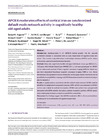APOE4 moderates effects of cortical iron on synchronized default mode network activity in cognitively healthy old-aged adults
Abstract
Introduction: Apolipoprotein E ε4 (APOE4)–related genetic risk for sporadic Alzheimer's disease is associated with an early impairment of cognitive brain networks. The current study determines relationships between APOE4 carrier status, cortical iron, and cortical network-functionality. Methods: Sixty-nine cognitively healthy old-aged individuals (mean age [SD] 66.1 [± 7.2] years; Mini-Mental State Exam [MMSE] 29.3 ± 1.1) were genotyped for APOE4 carrier-status and received 3 Tesla magnetic resonance imaging (MRI) for blood oxygen level–dependent functional magnetic resonance imaging (MRI) at rest, three-dimensional (3D)–gradient echo (six echoes) for cortical gray-matter, non-heme iron by quantitative susceptibility mapping, and 18F-flutemetamol positron emission tomography for amyloid-β. Results: A spatial pattern consistent with the default mode network (DMN) could be identified by independent component analysis. DMN activity was enhanced in APOE4 carriers and related to cortical iron burden. APOE4 and cortical iron synergistically interacted with DMN activity. Secondary analysis revealed a positive, APOE4 associated, relationship between cortical iron and DMN connectivity. Discussion: Our findings suggest that APOE4 moderates effects of iron on brain functionality prior to manifestation of cognitive impairment. © 2020 The Authors. Alzheimer's & Dementia: Diagnosis, Assessment & Disease Monitoring published by Wiley Periodicals, Inc. on behalf of the Alzheimer's Association. Show more
Permanent link
https://doi.org/10.3929/ethz-b-000465472Publication status
publishedExternal links
Journal / series
Alzheimer's & Dementia: Diagnosis, Assessment & Disease MonitoringVolume
Pages / Article No.
Publisher
WileySubject
APOE4; DMN; flutemetamol; fMRI; gradient echo; ICA; iron; MRI; PET; QSM; preclinical Alzheimer’s diseaseMore
Show all metadata




